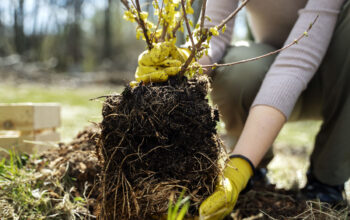Boston Fern (Nephrolepis exaltata)
Nephrolepis exaltata, known as the Boston fern or the sword fern, is a type of sword fern that originated in humid forests and swamps. It is also known as the Boston sword fern, wild Boston fern, Boston Blue Bell fern, Fishbone fern, or tuber ladder fern. Learn How to Grow and Care Boston Fern, Growing ferns in this article.
Studies have shown that the Boston fern could filter xylene, toluene, and formaldehyde from the air. It can reach as high as 40-90 centimeters and in extreme cases up to 1.5 meters.
Overview of Nephrolepis exaltata
Scientific name Nephrolepis exaltata
Common names Boston fern
Plant type Houseplant
Sun requirement indirect sunlight
Soil Well draining, loamy and airy
Soil pH 5.0- 5.5
Zone 10 – 12
Growing ferns
Boston Fern is perfect for the house and is one of many ferns that is suitable for indoor houseplants to fill some greenery in the house, and it also does not require high-maintenance. They are considered one of the easiest ferns to take care of and maintain. These ferns are also non-toxic to dogs and cats.
Soil
Nephrolepis exaltata prefer potting soil with high organic content and good drainage, and soil that is light, loamy, and airy. The potting soil for your plant should have peat moss or sphagnum for moisture retention, some sand or gravel for drainage, and sterilized bagged garden loam.
Light
Nephrolepis exaltata are perfect porch plants and they do best in indirect sunlight. They require reasonable light levels. They should be kept in a fairly bright spot that does not receive harsh sunlight so that they look happy and healthy.
The best location for Boston fern is a north-facing window, and south-facing should be avoided. The morning sun is the best and the full afternoon sun can burn the fronds. Make sure to change the light conditions of the plant when sunlight is more intense in summer and spring.
Humidity
Ferns love high humidity and can also survive an average level, but they cannot tolerate low humidity. They require a high level of humidity to thrive.
They do not prefer humidity lower than 80 percent, and in a drier environment, it should be frequently misted. When you care for Boston Ferns indoors, you should provide additional humidity for them You can mist your plant lightly once or twice a week in order to provide them the humidity they need.
Watering
The soil should always be moist in all seasons, except in winters. In winters, make sure to only water the plant when the soil surface is dry. Boston fern requires a lot of watering in hot weather.
Usually, Boston ferns need watering regularly. You can check whether your indoor fern needs watering or not by simply picking the container. If the container is heavy it means that the soil is moist and if the container feels light, it means it needs watering.
Do not overwater your plant, as it is likely to develop rot and other fungal diseases in waterlogged and soggy soil.
Fertilizer
An all-purpose liquid fertilizer at half-strength is good for your fern, and you can feed your Boston fern every other week. Make sure not to use the fertilizers on your plant after repotting until the roots have time to establish themselves.
Boston ferns are susceptible to some pests like mealybugs and spider mites. So, make sure to treat the plant as quickly as possible if it gets infected, to keep the plant healthy.
Repotting
Repot your plant only if you want it to grow bigger and when the roots have filled the existing pot. Make sure that you use the same soil level that it sat in before.
Nephrolepis exaltata repotting is done best in the spring season when the plant is actively growing. Some Boston ferns benefit from repotting every two or three years, and some fast-growing ferns may require potting more often.
Boston Fern Promotion
Boston propagation is very easy, you can split the plant when you are repotting it in the spring season. Do a little division because the root thrives in its very small division. Divide the segment of healthy roots, you can grow it by spore also, though it is relatively more difficult.
Read also:
How to grow Dieffenbachia houseplant. How to grow the Holly tree in containers. Growing and care for Orchids. Betel leaf plant growing and care guide. Cumin herb Growing at home. Growing Guduchi at home. Pitcher plants growing guide. Pak choi vegetable growing in containers. The perfect potting soil for your plants. Monster Deliciosa houseplants growing and care. Begonias growing in pots. Chrysanthemums plants growing and care tips.
For pin








